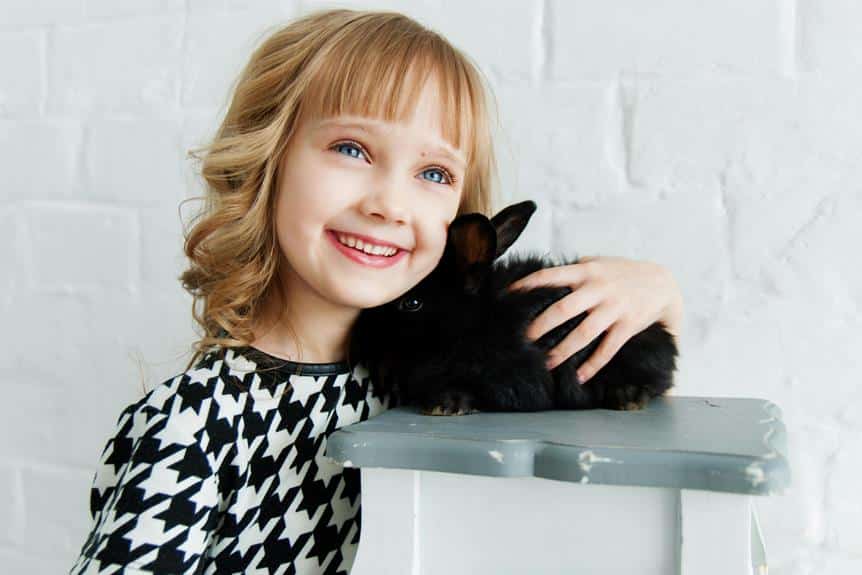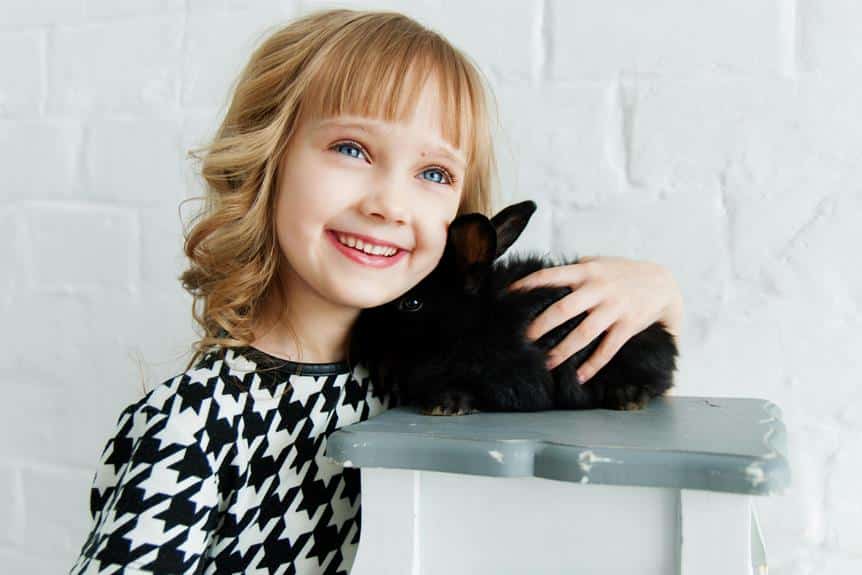Table of Contents
Like a carrot dangling in front of a hungry rabbit, your furry friend is eagerly awaiting to discover the seven ways you can show them just how much you love them.
These simple yet effective methods will not only strengthen the bond between you and your pet, but also ensure their well-being and happiness.
So, grab a cup of tea, sit back, and prepare to unravel the secrets of making your rabbit feel truly cherished.
Key Takeaways
- Bonding exercises, such as cuddle sessions, teaching tricks, and interactive play, are essential for building trust and strengthening the bond with your rabbit.
- Creating a safe and comfortable living environment by removing hazards, providing hiding spots, and a clean and spacious enclosure is crucial for your rabbit’s well-being.
- Offering a balanced and nutritious diet that includes high-quality grass hay, fresh vegetables, and appropriate rabbit pellets is important for their health.
- Regular grooming, including brushing, nail trimming, ear cleaning, and veterinary care, plays a vital role in maintaining your rabbit’s physical and mental well-being.
Spend Quality Time With Your Rabbit
To create a strong bond with your rabbit, it’s essential to spend quality time together through engaging activities and interactions. Bonding exercises are a great way to build trust and deepen your connection with your furry friend. These exercises involve spending one-on-one time with your rabbit, providing them with mental stimulation and enriching their environment.
One bonding exercise you can try is teaching your rabbit tricks. Rabbits are intelligent animals and can be trained to perform simple tricks like hopping through hoops or spinning in circles. This not only stimulates their minds but also strengthens the bond between the two of you.
Another activity you can engage in is interactive play. Provide your rabbit with toys that encourage physical activity and mental engagement, such as puzzle toys or treat-dispensing toys. This will keep them entertained and give them the opportunity to exercise their natural instincts.
Provide a Safe and Comfortable Living Environment
When creating a strong bond with your rabbit, it’s crucial to ensure their safety and comfort by providing them with a suitable living environment. One of the first steps in rabbit proofing your space is to remove any potential hazards. This includes electrical cords, toxic plants, and small objects that can be chewed on or swallowed. It’s also important to secure any loose wires or cables to prevent your rabbit from getting tangled or injured.
In addition to rabbit proofing, it’s essential to provide appropriate hiding spots for your furry friend. Rabbits are naturally prey animals and need a safe space where they can feel secure. You can achieve this by placing cardboard boxes or tunnels in their enclosure. These hiding spots provide a sense of security and allow your rabbit to retreat when they feel threatened or overwhelmed.
Furthermore, it’s crucial to provide your rabbit with a comfortable living environment. This includes ensuring they’ve a clean and spacious cage or enclosure. The enclosure should be large enough for your rabbit to stretch out and hop around. Additionally, it should be lined with soft bedding material such as hay or shredded paper for their comfort.
Offer a Balanced and Nutritious Diet
A balanced and nutritious diet is essential for maintaining the health and well-being of your rabbit. To ensure your furry friend’s optimal rabbit health, it’s crucial to understand their dietary needs.
Rabbits are herbivores, which means their diet should consist mainly of hay, fresh vegetables, and a small amount of pellets.
Hay is an essential component of a rabbit’s diet as it provides the necessary fiber for healthy digestion. It also helps wear down their constantly growing teeth. High-quality grass hay, such as timothy or orchard grass, should be available to your rabbit at all times.
Fresh vegetables are another vital part of their diet. Leafy greens like romaine lettuce, spinach, and kale are excellent choices. However, be cautious with vegetables high in oxalic acid, such as parsley and beet greens, as they can contribute to bladder stones.
Pellets should only make up a small portion of your rabbit’s diet. Look for pellets specifically formulated for rabbits, avoiding those with added seeds, nuts, or colored pieces. Feed them in moderation, as an excessive intake of pellets can lead to obesity and other health problems.
It is crucial to monitor your rabbit’s diet and adjust accordingly based on their individual needs. Remember to provide plenty of fresh water and consult with a veterinarian for specific dietary recommendations to ensure your rabbit’s optimal health.
Engage in Interactive Playtime Activities
Engaging in interactive playtime activities with your rabbit is a great way to strengthen your bond and provide mental and physical stimulation for your furry friend. Not only does it keep your rabbit physically active, but it also provides them with much-needed mental enrichment.
Here are four interactive playtime activities you can try with your rabbit:
- Interactive toys: Invest in toys that are specifically designed for rabbits. Look for toys that encourage your rabbit to use their natural instincts, such as puzzle toys that dispense treats when solved or toys that can be tossed and chased.
- Bonding exercises: Use playtime as an opportunity to bond with your rabbit. Gentle petting and grooming sessions can help build trust and strengthen your relationship. Additionally, you can try teaching your rabbit simple tricks like hopping over obstacles or coming when called, using positive reinforcement techniques.
- Hide and seek: Hide treats or small toys around a designated play area and encourage your rabbit to find them. This game stimulates their natural foraging instincts and keeps them mentally engaged.
- Agility training: Set up a mini agility course using tunnels, ramps, and hurdles. Teach your rabbit to navigate through the obstacles using rewards and praise. Not only is this a fun and challenging activity, but it also helps to keep your rabbit physically fit.
Groom Your Rabbit Regularly
To keep your rabbit looking and feeling their best, regular grooming is essential. Brushing their fur not only removes loose hair but also helps distribute natural oils for a healthy coat.
Don’t forget about their nails – regular trimming is important to prevent overgrowth and discomfort.
Lastly, cleaning their ears is crucial to prevent infections.
Brushing for Healthy Fur
Regularly grooming your rabbit by brushing its fur is essential for maintaining its overall health and well-being. Here are four reasons why proper brushing technique and regular brushing are beneficial for your furry friend:
- Prevents fur matting: Regular brushing helps to remove loose hairs and prevent them from tangling and forming painful mats in your rabbit’s fur.
- Reduces hairballs: By brushing your rabbit regularly, you decrease the amount of hair they ingest while grooming themselves, reducing the risk of hairballs and potential gastrointestinal issues.
- Improves circulation: Brushing stimulates blood flow to your rabbit’s skin, promoting a healthy coat and preventing skin issues.
- Bonding time: Grooming your rabbit not only keeps them looking their best but also strengthens your bond with them. It’s an opportunity for gentle touch and interaction, which rabbits appreciate and enjoy.
Nail Trimming Importance
Regular nail trimming is a crucial aspect of grooming your rabbit to ensure their overall health and well-being. Nail maintenance is essential because rabbits’ nails can grow quickly and become sharp and long if not trimmed regularly. Long nails can cause discomfort and pain for your rabbit, leading to difficulty in walking, injury, or even infection.
To maintain proper nail length, it’s recommended to trim your rabbit’s nails every 4-6 weeks. When trimming, be careful not to cut too close to the quick, which is the sensitive part of the nail that contains blood vessels and nerves.
To make nail trimming a stress-free experience for your rabbit, you can use positive reinforcement and offer treats as rewards. By incorporating regular nail trimming into your rabbit’s hygiene practices, you’re ensuring their comfort and preventing potential health issues.
Cleaning Their Ears
Now that you understand the importance of nail trimming for your rabbit’s health, let’s move on to another crucial aspect of grooming – cleaning their ears.
Regular ear cleaning is essential for maintaining your rabbit’s overall well-being and preventing ear infections. Here are some ear cleaning tips to ensure your furry friend stays happy and healthy:
- Gather the necessary supplies: You’ll need a small, soft cloth or cotton ball, a rabbit-safe ear cleaning solution, and treats to reward your rabbit after the procedure.
- Be gentle and cautious: Your rabbit’s ears are sensitive, so approach the cleaning process with care. Avoid inserting anything deep into the ear canal to prevent injury.
- Clean the outer ear only: Dampen the cloth or cotton ball with the ear cleaning solution and gently wipe the outer part of your rabbit’s ear, removing any dirt or debris.
- Monitor for signs of infection: Regular ear cleaning allows you to check for any redness, swelling, discharge, or unpleasant odor that may indicate an ear infection. If you notice any of these symptoms, consult a veterinarian promptly.
Show Affection Through Gentle Handling and Petting
To show affection to your rabbit, gently handle and pet them using a calm and reassuring approach. Rabbits are naturally skittish animals, so it’s important to create a safe and comfortable environment for them. Before attempting any handling or petting, make sure your rabbit is comfortable with you and their surroundings. Start by spending time near their enclosure, talking softly to them, and offering treats. This will help build trust and familiarity.
When it comes to handling your rabbit, always approach them from the side rather than from above. This helps them feel less threatened and more at ease. Gently scoop them up, supporting their hindquarters, and hold them close to your chest. Avoid any sudden movements or loud noises, as this can startle them.
Petting your rabbit is a wonderful way to show them affection. Begin by stroking their forehead and gradually move down their back. Pay attention to their body language and if they seem uncomfortable, adjust your approach accordingly. Some rabbits enjoy being scratched behind their ears or under their chin. Experiment with different areas to find what your rabbit enjoys most.
Bonding exercises, such as cuddle sessions, are beneficial for both you and your rabbit. These sessions allow for physical contact and help strengthen your bond. Make sure to choose a quiet and calm environment for cuddle time, and let your rabbit approach you at their own pace.
Remember to always be patient and gentle, as your rabbit’s trust and comfort are essential for a loving and affectionate relationship.
Seek Regular Veterinary Care and Attention
Taking your rabbit to the veterinarian regularly is essential for maintaining their health and well-being. Regular check-ups and preventive care are crucial in ensuring that your furry friend stays happy and healthy.
Here are four reasons why seeking regular veterinary care and attention for your rabbit is so important:
- Early detection of health issues: Regular check-ups allow veterinarians to detect any potential health problems in your rabbit before they become serious. This helps to prevent unnecessary suffering and ensures prompt treatment if needed.
- Vaccinations: Rabbits are susceptible to certain diseases that can be prevented through vaccinations. Regular visits to the vet will ensure that your rabbit receives the necessary vaccinations to protect them from these diseases.
- Dental care: Rabbits have unique dental needs, and regular veterinary visits can help to prevent dental issues such as overgrown teeth or dental infections. Your vet can provide guidance on proper dental care and perform necessary dental procedures if required.
- Overall well-being: Regular veterinary care ensures that your rabbit receives a thorough examination and proper care. This not only helps to maintain their physical health but also contributes to their overall well-being and quality of life.



